When considering long-term apartment stays in Australia, rates typically range from AUD 1,500 to AUD 3,500 per month, influenced by factors such as location, size, and included amenities. To maximize savings, exploring off-peak discounts and being flexible with travel dates can lead to more affordable options. Many long-term rentals come with a range of amenities, enhancing the overall living experience based on the rental price and location.
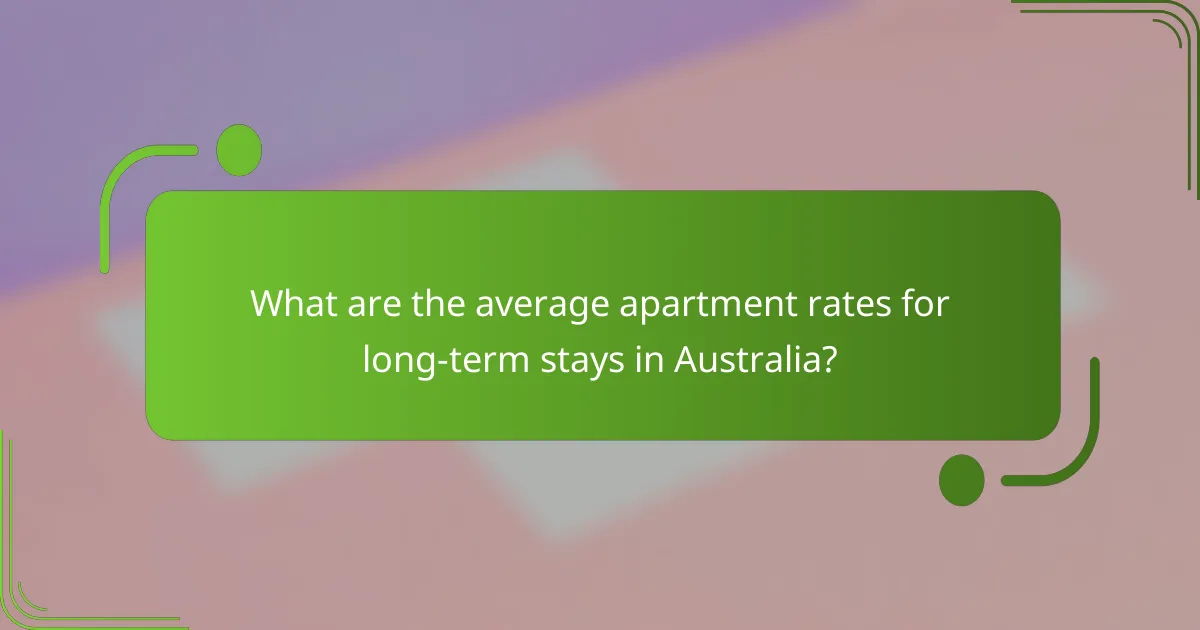
What are the average apartment rates for long-term stays in Australia?
The average apartment rates for long-term stays in Australia typically range from AUD 1,500 to AUD 3,500 per month, depending on location, size, and amenities. Factors such as lease length and seasonal demand can also influence these rates.
Rates in major cities
In major Australian cities like Sydney and Melbourne, long-term apartment rates can be on the higher end, often exceeding AUD 3,000 monthly for one-bedroom units in central areas. Brisbane and Perth may offer slightly lower rates, generally ranging from AUD 1,800 to AUD 2,500 for similar accommodations.
For example, a two-bedroom apartment in Sydney’s central business district can cost around AUD 4,500, while the same type of apartment in Melbourne might be priced at AUD 3,800. These prices reflect the high demand and limited supply in urban centers.
Regional variations
Regional areas in Australia tend to have more affordable long-term rental rates. Cities like Hobart and Adelaide often see monthly rates between AUD 1,200 and AUD 2,000 for one-bedroom apartments. This price difference can be attributed to lower demand and a larger supply of available properties.
In rural areas, rates can drop significantly, with some apartments available for under AUD 1,000 per month. However, amenities and services may be limited compared to urban settings.
Factors affecting pricing
Several factors influence long-term apartment pricing in Australia, including location, size, and the condition of the property. Proximity to public transport, schools, and shopping centers can drive prices higher, especially in metropolitan areas.
Additionally, the time of year can impact rates. Off-peak seasons, typically during winter months, may offer discounts or lower prices, while peak seasons, such as summer, often see increased demand and higher rates. It’s advisable to negotiate lease terms and explore various listings to find the best deals.
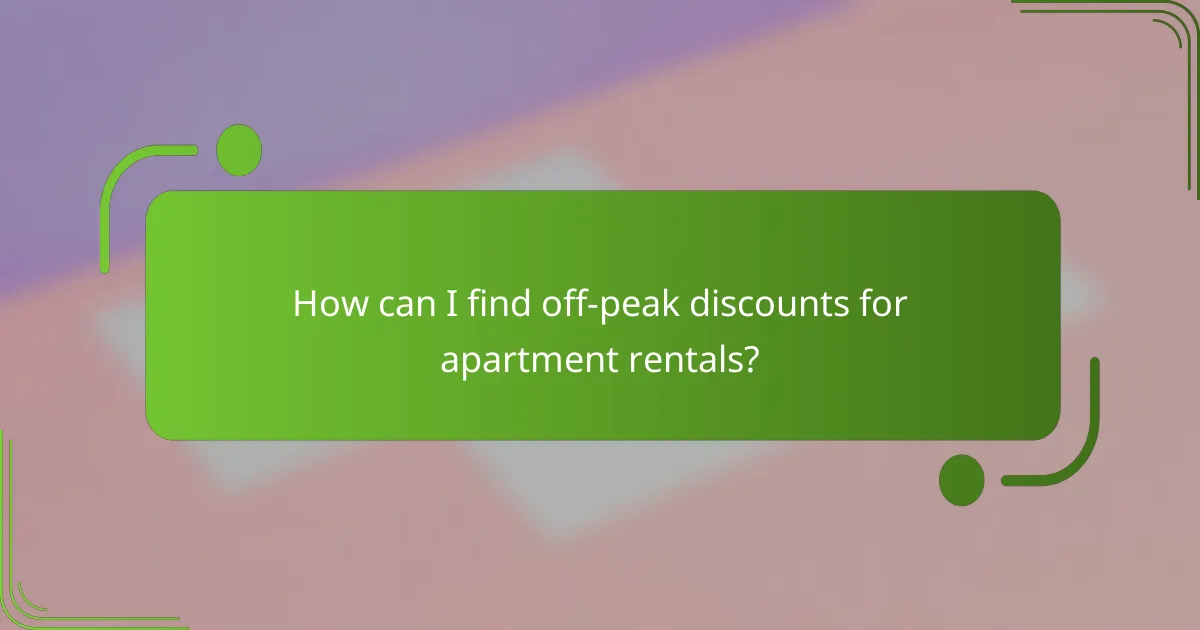
How can I find off-peak discounts for apartment rentals?
To find off-peak discounts for apartment rentals, start by researching seasonal trends in rental prices and utilizing various online platforms that specialize in discounts. Being flexible with your travel dates can also significantly increase your chances of securing a lower rate.
Seasonal pricing trends
Apartment rental prices often fluctuate based on the season. Typically, demand is lower during the winter months, leading to potential discounts. Conversely, summer and holiday seasons usually see higher rates due to increased demand.
For example, if you plan to rent in a popular tourist destination, consider booking during the shoulder seasons—just before or after peak times—to take advantage of lower rates. This can result in savings of 10-30% compared to peak pricing.
Popular discount platforms
Several online platforms can help you find off-peak discounts on apartment rentals. Websites like Airbnb, Vrbo, and Booking.com often feature special offers or promotional rates during off-peak seasons.
Additionally, consider using aggregators like Kayak or Trivago, which compare prices across multiple sites, helping you identify the best deals available. Signing up for newsletters from these platforms can also provide exclusive discounts and alerts on price drops.
Negotiation tips
When looking for off-peak discounts, don’t hesitate to negotiate directly with property owners or managers. Many are willing to offer lower rates for longer stays or during less busy times.
Prepare to make your case by highlighting your flexibility with dates or your intention to book a longer-term stay. Offering to pay in full upfront can also strengthen your position in negotiations, potentially leading to a better deal.
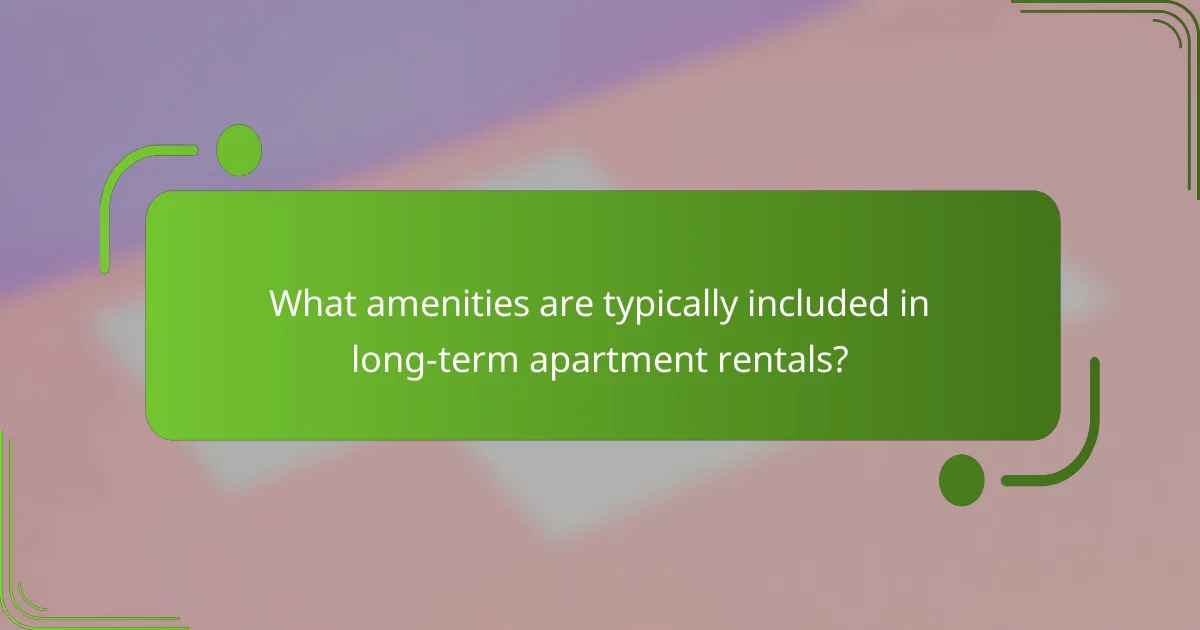
What amenities are typically included in long-term apartment rentals?
Long-term apartment rentals often include a variety of amenities that enhance comfort and convenience. Common features may range from basic utilities to more luxurious options, depending on the rental price and location.
Common amenities offered
Typical amenities in long-term apartment rentals include essential utilities such as water, electricity, and gas. Many apartments also provide internet access, heating, and air conditioning. Additional features might include laundry facilities, parking spaces, and access to communal areas like gyms or pools.
Some rentals may offer furnished options, which can save tenants the hassle of buying or transporting furniture. It’s advisable to clarify what is included in the rental agreement to avoid unexpected costs.
Luxury vs budget options
Luxury apartments often come with high-end amenities such as smart home technology, concierge services, and premium appliances. These units may also feature enhanced security systems and exclusive access to facilities like rooftop terraces or private lounges.
In contrast, budget options typically focus on essential amenities without the frills. While they may lack some of the luxury features, they can still provide comfortable living conditions at a more affordable price point. When choosing between the two, consider your lifestyle needs and budget constraints to find the best fit.
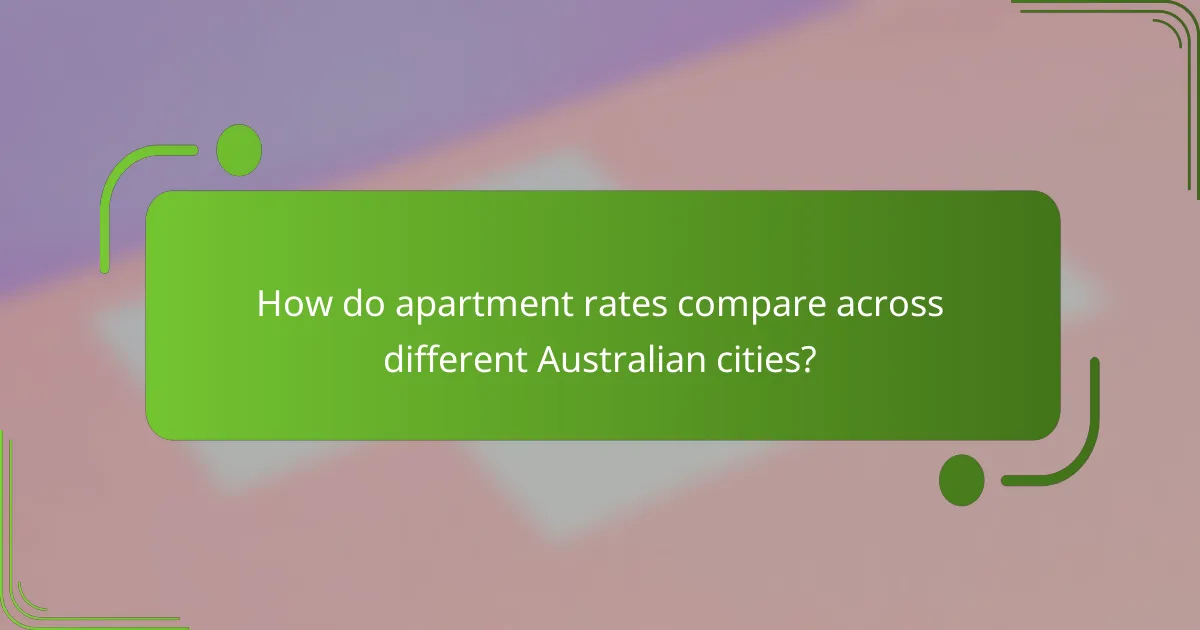
How do apartment rates compare across different Australian cities?
Apartment rates in Australia vary significantly between cities, influenced by factors such as location, demand, and amenities. Generally, major cities like Sydney and Melbourne have higher rental prices compared to Brisbane and Perth, making it essential for renters to consider their budget and preferences when choosing a location.
Sydney vs Melbourne rates
Sydney typically has higher apartment rates than Melbourne, with average monthly rents often exceeding AUD 3,000 for a one-bedroom in the city center. In contrast, Melbourne’s rates for similar accommodations usually range from AUD 2,500 to AUD 3,000, depending on the area and amenities offered.
When comparing these two cities, consider factors such as lifestyle, job opportunities, and public transport. Sydney’s vibrant beach culture and nightlife may appeal to some, while Melbourne’s arts scene and coffee culture attract others.
Brisbane and Perth comparisons
Brisbane and Perth generally offer more affordable apartment rates compared to Sydney and Melbourne. In Brisbane, one-bedroom apartments in the city center can cost around AUD 2,000 to AUD 2,500, while Perth’s rates are similar, often falling within the AUD 1,800 to AUD 2,400 range.
Both cities provide a more relaxed lifestyle, with Brisbane known for its warm climate and outdoor activities, and Perth boasting beautiful beaches and a laid-back atmosphere. Renters should weigh these lifestyle factors alongside cost when deciding between these two cities.

What criteria should I consider when choosing an apartment for long-term stays?
When selecting an apartment for long-term stays, focus on location, lease terms, and included amenities. These factors significantly impact your living experience, costs, and convenience.
Location and accessibility
Location is crucial for long-term apartment stays as it affects daily life, including commuting, shopping, and leisure activities. Consider proximity to public transport, workplaces, schools, and essential services like grocery stores and hospitals.
Accessibility also matters; ensure the area is safe and well-connected. Research local crime rates and neighborhood amenities to gauge the overall environment. A desirable location can enhance your quality of life and may justify higher rental costs.
Lease terms and conditions
Understanding lease terms is essential for long-term stays. Look for the duration of the lease, renewal options, and any penalties for early termination. Standard leases can range from six months to a year, but some may offer more flexible arrangements.
Additionally, review conditions regarding rent increases, maintenance responsibilities, and rules about subletting. Clear lease terms can prevent misunderstandings and ensure a smoother living experience. Always read the fine print before signing to avoid potential pitfalls.

How do off-peak discounts affect overall rental costs?
Off-peak discounts can significantly lower rental costs for long-term stays by offering reduced rates during less popular times. These discounts typically apply to specific months or days when demand is lower, allowing renters to save money while enjoying the same amenities.
Potential savings analysis
Renters can expect savings ranging from 10% to 30% during off-peak periods compared to peak rates. For example, if a standard monthly rent is $1,500, an off-peak discount could reduce the cost to between $1,050 and $1,350. This can lead to substantial savings over a year, especially for long-term leases.
It’s important to compare the off-peak rates with peak pricing to determine the best time to rent. Consider creating a simple table to track potential savings across different months or weeks to visualize the impact of these discounts.
Impact on rental agreements
Off-peak discounts often come with specific rental agreements that may include longer minimum stay requirements or restrictions on cancellation policies. Renters should carefully review these terms to ensure they align with their plans and flexibility needs.
Additionally, some landlords may offer incentives, such as waived fees or included utilities, during off-peak seasons. Understanding these terms can help renters maximize their savings while securing a favorable rental agreement.
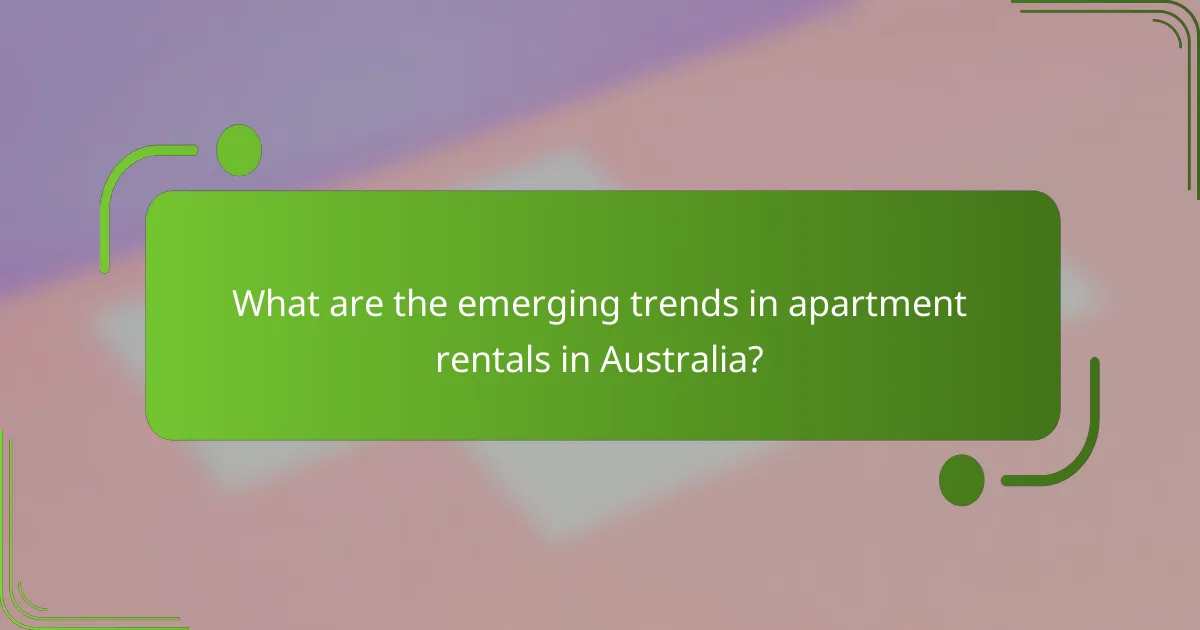
What are the emerging trends in apartment rentals in Australia?
Emerging trends in apartment rentals in Australia indicate a shift towards more flexible leasing options and a growing demand for eco-friendly amenities. These trends reflect changing tenant preferences and a response to environmental concerns.
Shift towards flexible leases
Flexible leases are becoming increasingly popular among renters in Australia, allowing tenants to choose shorter-term agreements or month-to-month options. This trend caters to the needs of individuals who may require temporary housing due to work assignments or lifestyle changes.
Landlords are adapting by offering a variety of lease terms, which can range from a few months to a year. This flexibility not only attracts a broader tenant base but also helps landlords reduce vacancy rates during uncertain economic times.
Increased demand for eco-friendly amenities
There is a notable rise in the demand for eco-friendly amenities in Australian apartments, driven by tenants’ growing awareness of sustainability. Features such as energy-efficient appliances, solar panels, and water-saving fixtures are now highly sought after.
Landlords who invest in these green amenities may find themselves with a competitive edge, as they can justify higher rental prices and attract environmentally conscious renters. Additionally, properties with eco-friendly features often enjoy lower utility costs, benefiting both tenants and landlords in the long run.
